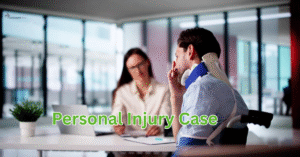Personal Injury Case: Everything You Should Know Before Filing

You can file a personal injury case when someone else’s carelessness hurts you. But you do not have unlimited time or automatic payment. Utah law sets rules on when and how you can ask for money for medical bills, lost wages, pain, and other losses. The process starts the day you are hurt.
Quick medical care, good records, and legal guidance can make a real difference in what you recover. In this guide, we walk through the basics so you know what to do before you file. Read it now, save it, and use it to ask better questions when you meet with a lawyer.
Key Points You Should Know
- Deadlines apply.
- Get medical care right away.
- Save every bill and record.
- Photos and witness names matter.
- Insurance is not always fair.
- Fault rules can cut recovery.
- Utah has no-fault auto basics.
- Do not talk to adjusters alone.
- Value pain and future care.
- A lawyer helps raise a claim’s strength.
What is Personal Injury Law?
Personal injury law deals with cases where an individual is injured because another person, business, or institution acted negligently, failing to act in the same way a reasonable person would have. From personal injury laws, it is necessary that such reports are published to help the injured party since these types of laws are designed to ensure the injured victim gets full compensation for the injuries they sustain.
Core ideas:
- Duty of care: Property owners must fix hazards or warn visitors. Doctors must treat patients to accepted medical standards.
- Breach of duty: Someone failed to meet that duty. Maybe a driver was texting. Maybe a store left ice on a walkway. Maybe a nurse gave the wrong dose.
- Causation: The breach caused the injury. You must show the harm would not have happened without the careless act and that the type of harm was a likely result.
- Damages: Real losses flowed from the injury. Bills, lost income, reduced ability to work, pain, and future care needs count.
Cases are handled through insurance claims, settlement talks, or lawsuits filed in court. Most resolve through settlement, but a strong case is prepared as if a trial may happen.
Most Common Types of Personal Injury Cases
No one ever schedules time to get hurt, but thousands of those visits walk into the doors of Utah offices every day. Whether it is a motor vehicle accident on I-15, a slip and fall on icy winter sidewalks or a workplace accident at a construction site, the same question arises: who is paying? And the facts may come and go, but the bare bones of a claim remain constant.
Motor Vehicle Accidents (Cars, SUVs, Motorcycles)
Auto crashes lead the list nationwide and in Utah. Even minor fender benders can hide whiplash, concussions, or back injuries that flare later. Utah follows a no-fault personal injury protection (PIP) system for auto injuries up to a set amount, so your own auto policy may pay early medical costs no matter who caused the crash. Serious injury claims that pass the PIP threshold may then pursue the at-fault driver’s insurance. Key proof includes police reports, crash scene photos, medical records, repair bills, and phone records if distracted driving is suspected.
Truck Accidents (Large Commercial Vehicles)
Semi trucks and delivery rigs weigh many times more than passenger cars. Injuries are often severe. Trucking cases add layers: federal and state safety rules, driver logbooks, maintenance records, and cargo loading practices. Multiple parties can share fault, including the driver, the carrier, a maintenance shop, or a shipper. Quick action to secure electronic control module data (the truck’s “black box”) can preserve speed and braking info that may vanish if the truck is put back in service.
Motorcycle Crashes
Motorcycle operators do not have the steel cage to protect them from injury like car occupants do. Typically, they will suffer road rash, broken bones, significant brain injury, and spinal injury. Additionally, if the bias against riders is not met with political will and substantial proof, they may obtain a lower settlement value.
Pedestrian and Bicycle Injuries
Utah’s web of bike trails and bike lanes is growing more widespread, and it helps; however, there are still pedestrian and bicycle collisions that occur more frequently than drivers recognize at crosswalks, driveways, and corners. For example, drivers going to the right of the stop sign frequently do not observe people in the crosswalk. Speed, poor lighting, and phone distraction add risk. Injured walkers and cyclists can claim medical costs, lost income, and pain. Reflective gear, traffic camera footage, and eyewitness names are helpful. City street design data may matter in larger cases against a city or contractor.
Slip, Trip and Fall Accidents
Ice, liquid spills, ripped carpets, unsecured cords and broken stairs lead to falls in shops, houses, apartments and public areas. Ice cases in parking lots and on sidewalks are common during Utah winters. Brief photographs of the condition, reports of the incident, and weather data on the day of the fall confirm assertions. A slip and fall attorney would also review cleaning logs and maintenance contracts.
Medical Malpractice
If a healthcare provider’s care is substandard and causes harm, you may have a malpractice case. They can include misdiagnoses, surgical errors, birth injuries, and medication mistakes. These cases require expert medical review and can take time. Utah has special procedures, including pre-litigation panels, before full suit in many situations. Good record gathering and early expert input are key. A skilled medical malpractice attorney coordinates the medical proof.
Defective Products (Product Liability)
Unsafe products can injure users even when used correctly. Faulty car parts, household tools, toys, and medical devices are common targets. Product cases may rest on design flaws, manufacturing errors, or poor warnings. Save the item, packaging, manuals, and proof of purchase. Large cases may group many injured users in joint suits or class actions. Expert engineering review often drives results.
Dog Bites and Animal Attacks
Utah law can hold dog owners responsible when their animals bite or injure someone, even if the dog has never bitten before. Kids are frequent victims and may face scars and an increased risk. Get medical care quickly for wound cleaning and shots.
Wrongful Death
When a person dies due to another’s careless or wrongful act, close family members may file a wrongful death action. These cases seek money for final medical care, funeral costs, lost income the person would have earned, and the loss of love, care, and guidance. Wrongful death can arise from any of the prior categories, from crashes to medical errors. Filing rules on who can bring the claim vary, so early legal help is important.
Other case types you may hear about: nursing home neglect, assault related injury suits, and toxic exposure claims. If you are not sure where your situation fits, ask during your free consultation with a personal injury attorney.
Common Causes of Personal Injury Cases
Injuries do not fall from clear blue skies. They usually tie back to choices, conditions, and risky habits that could have been prevented. Spotting the root cause helps prove fault and can improve safety going forward.
Here are the frequent causes that lead Utah families to call an accident injury attorney.
Frequent cause categories:
- Impaired driving from alcohol or drugs
- Winter road ice and poor snow removal
- Not yielding at lights or stop signs
- Defective tools, auto parts or household products
- Medical errors (wrong dose or time gap in evaluation)
- Fatigued truck and shift workers
- No safety gear on the job site
Any one of these factors may trigger a “domino effect” that ends with a Personal Injury Case. When you meet with a personal injury lawyer, you can tell him or her all of the details you can remember, no matter how small. A photo of a warning sign, a weather report, or a name scribbled on a receipt can be a link to your injury.
How to Prove Negligence in a Personal Injury Case?
A person’s negligence causes harm to someone by not acting in a reasonable way in a similar situation. Four elements must be proven to recover money: duty, breach, cause, and damages. They can be thought of as links in a chain. If you break a link, you weaken the case.
Steps to build proof:
- Show duty: Use laws, rules, contracts, or common sense standards. Traffic laws set duties for drivers. Building codes set duties for property owners.
- Show breach: Gather evidence that the duty was missed.
- Show causation: Connect the breach to the injury. Medical records and doctor testimony can link the crash or fall to your diagnosed condition. Accident reconstruction experts may show how the event unfolded.
- Show damages: List and prove every loss. Medical bills, pay stubs, repair invoices, home care costs, and personal statements about pain and limits support value.
Utah also follows a modified comparative fault rule. Depending on how much blame you bear, your money may decrease. There may be no recovery from the other party if you are 50% or more at fault. Good evidence helps push your fault share down.
Why is Hiring a Personal Injury Attorney Important?
Insurance companies handle claims every day. Injured people usually do not. A seasoned lawyer levels that field. An attorney gathers proof, values claims, deals with insurers, and files suit if talks fail. This frees you to heal while your case moves forward.
When you work with a Personal Injury Lawyer Utah residents count on, you also gain state-specific experience. Utah has unique deadlines, damage rules, and auto insurance steps that set it apart from others. Local attorneys are familiar with the judges, medical experts and insurance adjusters in the area.
If you need assistance, the group at Cockayne Law serves those injured statewide.
FAQs
How long do I have to file a case in Utah?
Deadlines vary. Many injury lawsuits must be filed within four years, but some claims shorten to two years or less, such as some claims against a government body. Ask a lawyer right away so you do not lose rights.
What is the most famous personal injury case?
Many people cite the McDonald’s hot coffee burn case. A woman suffered severe burns from superheated coffee, and evidence showed prior burn complaints. The jury awarded money to cover care and to send a message. The case is often misunderstood, yet it highlights burn injury risks and product safety duties.
Do I need a lawyer if the insurance company made an offer?
You can settle on your own, but you risk leaving money on the table. Insurers aim to close claims cheaply. A personal injury attorney can review medical proof, future care, and lost income to see if the offer is fair. Many review offers at no cost.
How are pain and suffering valued?
There is no fixed chart. Insurers consider injury type, treatment length, lasting limits, and impact on daily life. Some use software models. Strong medical notes and personal impact statements help raise value. Photos, therapy notes, and family input add weight.
What if I were partly at fault?
Utah’s modified comparative fault rule lets you recover money if you are less than 50 percent at fault. Good evidence helps lower your fault percent.
How much is my case worth?
Value depends on medical bills, lost income, future care needs, pain, and fault splits. Serious long-term injuries raise value. Minor sprains are worth less. Only after treatment and record review can an attorney give a range. Be wary of early promises without proof.
How can Cockayne Law help me?
Cockayne Law reviews your facts, gathers records, and deals with insurers so you can heal. They handle car crashes, slips, medical errors, and other claims statewide. Contact them for a free review with a Personal Injury Lawyer Utah residents trust. Quick advice can protect your rights.








